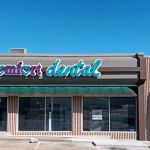What Causes Enamel Erosion and How to Protect It
Enamel erosion is a common dental problem that can cause long-term damage to your teeth if left unchecked. As the hard, protective outer layer of your teeth, enamel is essential for maintaining oral health and protecting against decay. However, many factors can contribute to enamel erosion, including dietary choices, lifestyle habits, and underlying health conditions. In this article, we’ll explore what causes enamel erosion, the symptoms to look out for, and most importantly, how you can protect your teeth from further damage.
1. What Is Enamel and Why Is It Important?
Enamel is the hardest substance in the human body, designed to protect your teeth from physical damage and acid erosion. This outer layer plays a vital role in keeping your teeth intact, preventing cavities, and maintaining their structure. Enamel does not regenerate, which means once it's damaged or eroded, it cannot be repaired naturally. This is why it's important to take proactive steps in maintaining its health and strength.
Unfortunately, despite its strength, enamel is not invulnerable. Certain habits, foods, and even natural processes can contribute to enamel loss, leaving your teeth vulnerable to decay, sensitivity, and other oral health issues.
2. Causes of Enamel Erosion
Several factors contribute to enamel erosion, and some may surprise you. Understanding the causes is essential for prevention. Here are some common culprits:
- Acidic Foods and Drinks: Consuming highly acidic foods like citrus fruits, soda, and wine can erode enamel. These substances lower the pH levels in your mouth, making it easier for enamel to break down.
- Brushing Too Hard: Using a hard-bristled toothbrush or brushing your teeth aggressively can wear away enamel over time. It’s important to use a soft-bristled brush and gentle motions to protect your enamel.
- Dry Mouth: A lack of saliva production, often caused by medications or health conditions, can lead to enamel erosion. Saliva helps neutralize acids and remineralize enamel, so reduced saliva flow makes your teeth more susceptible to damage.
- Acid Reflux: Gastroesophageal reflux disease (GERD) can cause stomach acids to reach the mouth, leading to enamel erosion. If you experience frequent heartburn or regurgitation, it’s important to address the underlying issue with your healthcare provider.
- Grinding Your Teeth: Bruxism, or teeth grinding, is often a subconscious habit that can wear down enamel, especially if done over long periods. This condition can be particularly damaging when coupled with stress or anxiety.
Understanding these causes is essential in preventing enamel erosion and protecting your oral health from further damage.
3. Signs of Enamel Erosion
Enamel erosion can develop slowly, and it’s often hard to notice until it has advanced. However, there are some signs to look out for:
- Tooth Sensitivity: One of the first signs of enamel erosion is increased tooth sensitivity, especially to hot, cold, or sweet foods and beverages.
- Discoloration: As enamel erodes, the yellowish dentin beneath it becomes more visible, leading to a yellowing of the teeth.
- Rough or Jagged Edges: Enamel erosion can cause the edges of your teeth to become rough, chipped, or jagged.
- Visible Cracks: Severe enamel erosion can cause cracks in your teeth, making them more prone to cavities and other dental issues.
If you notice any of these symptoms, it’s important to visit your dentist for an evaluation and treatment options to prevent further damage.
4. How to Protect Your Enamel from Erosion
Preventing enamel erosion is all about protecting your teeth from harmful acids and maintaining good oral hygiene. Here are several tips to help preserve your enamel:
- Practice Good Oral Hygiene: Brush your teeth twice a day with fluoride toothpaste and floss daily. Fluoride helps remineralize enamel, making it more resistant to acid erosion.
- Limit Acidic Foods and Drinks: Avoid consuming too many acidic foods and drinks, and when you do, rinse your mouth with water afterward to neutralize acids.
- Use a Soft-Bristled Toothbrush: Brush your teeth gently with a soft-bristled toothbrush to avoid scrubbing away enamel.
- Wear a Mouthguard: If you grind your teeth at night, consider wearing a custom mouthguard to protect your enamel from excessive wear and tear.
- Stay Hydrated: Drinking plenty of water helps maintain saliva flow, which helps neutralize acids in your mouth and remineralize your enamel.
By following these preventive measures, you can significantly reduce your risk of enamel erosion and maintain strong, healthy teeth for years to come.
5. Treatment Options for Enamel Erosion
If your enamel has already begun to erode, don’t panic. There are treatment options available to help restore your teeth’s appearance and function:
- Dental Bonding: In cases of mild erosion, dental bonding can help restore the shape and function of your teeth by applying a tooth-colored resin.
- Veneers: For more severe enamel erosion, porcelain veneers can be placed over your teeth to improve their appearance and protect the underlying layers.
- Fluoride Treatments: Professional fluoride treatments can help remineralize enamel, making it stronger and more resistant to further erosion.
- Crowns: If enamel erosion is extensive, dental crowns may be used to cover and protect the damaged teeth.
Consult with your dentist to determine the best treatment option for your specific case of enamel erosion.
6. How to Maintain Healthy Enamel in the Long Term
Maintaining healthy enamel requires a combination of good habits and regular dental check-ups. Here are some tips to ensure your enamel stays in top condition:
- Regular Dental Visits: Schedule check-ups with your dentist at least twice a year. Your dentist can detect early signs of enamel erosion and recommend treatments to prevent further damage.
- Healthy Diet: Eating a balanced diet rich in calcium, phosphorus, and vitamins will help support enamel health. Dairy products, leafy greens, and fish are great choices for strengthening your teeth.
- Use Enamel-Strengthening Products: Consider using toothpaste designed to strengthen enamel or products that provide added protection against acids.
By adopting these long-term practices, you’ll be able to maintain strong enamel and protect your teeth for years to come.
Conclusion: Enamel Protection Is Essential for Lifelong Oral Health
Enamel erosion is a serious issue that can lead to tooth sensitivity, decay, and other dental problems. However, by understanding the causes of enamel erosion and taking proactive steps to protect your enamel, you can preserve your oral health for years to come. Good oral hygiene, a healthy diet, and regular dental visits are all essential to maintaining strong and healthy teeth. If you’re concerned about enamel erosion, schedule an appointment with your dentist to explore treatment options and take the necessary steps to protect your smile.
For more information on protecting your enamel, visit Dentistry Toothtruth and explore our range of oral care products and tips for a healthier smile.







 Comfort Dental South Independence – Your Trusted Dentist in Independence4.0 (334 review)
Comfort Dental South Independence – Your Trusted Dentist in Independence4.0 (334 review) Chaska Family Dental4.0 (266 review)
Chaska Family Dental4.0 (266 review) Gentle Family Dentistry5.0 (60 review)
Gentle Family Dentistry5.0 (60 review) Tend East Nashville4.0 (319 review)
Tend East Nashville4.0 (319 review) Riverside Family Dental4.0 (431 review)
Riverside Family Dental4.0 (431 review) Second Street Dental4.0 (423 review)
Second Street Dental4.0 (423 review) The Importance of Oral Health Education During Pregnancy for a Healthy Pregnancy
The Importance of Oral Health Education During Pregnancy for a Healthy Pregnancy Best Tips for Brushing Your Teeth Properly for Healthy Gums: Essential Techniques for Oral Health
Best Tips for Brushing Your Teeth Properly for Healthy Gums: Essential Techniques for Oral Health Why Skipping Dental Checkups Can Lead to Bigger Oral Health Problems
Why Skipping Dental Checkups Can Lead to Bigger Oral Health Problems Advantages of Porcelain Dental Restorations
Advantages of Porcelain Dental Restorations How Can Diabetes Cause Tooth and Gum Problems? Preventing and Managing Oral Health Issues
How Can Diabetes Cause Tooth and Gum Problems? Preventing and Managing Oral Health Issues Healthy Habits for Promoting Good Oral Health and Hygiene: Tips for a Healthy Smile
Healthy Habits for Promoting Good Oral Health and Hygiene: Tips for a Healthy Smile